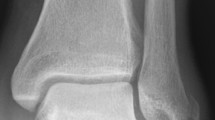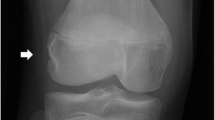Abstract
We report a case of intermittent dislocation of the flexor hallucis longus at its passage in the retro-malleolar area, related to a post-traumatic detachment of the retrotalar pulley from the medial tubercle of the talus. High-resolution ultrasound depicted the anterior dislocation of the tendon during dynamic stress, by asking the patient to flex his hallux against the examiner resistance, with the ankle in slight dorsiflexion. The tendon normally relocated after the dynamic maneuver. Tendon dislocation was associated with a painful snap.



Similar content being viewed by others
References
Tamborrini G, Bianchi S (2020) Ultraschall des Fusses (adaptiert nach SGUM-Richtlinien) Ultrasound of the foot (adapted according to SGUM guidelines). Praxis (Bern 1994) 109(13):1074–1084. https://doi.org/10.1024/1661-8157/a003541
Zaottini F, Picasso R, Pistoia F et al (2020) Ultrasound imaging guide for assessment of the intrinsic ligaments stabilizing the subtalar and midtarsal joints. Semin Musculoskelet Radiol 24(2):113–124. https://doi.org/10.1055/s-0040-1710066
Becciolini M, Bonacchi G, Stella SM, Galletti S, Ricci V (2020) High ankle sprain: sonographic demonstration of a posterior inferior tibiofibular ligament avulsion. J Ultrasound 23(3):431–433. https://doi.org/10.1007/s40477-020-00455-w
Demondion X, Canella C, Moraux A, Cohen M, Bry R, Cotten A (2010) Retinacular disorders of the ankle and foot. Semin Musculoskelet Radiol 14(3):281–291. https://doi.org/10.1055/s-0030-1254518
De Maeseneer M, Madani H, Lenchik L et al (2015) Normal anatomy and compression areas of nerves of the foot and ankle: US and MR imaging with anatomic correlation. Radiographics 35(5):1469–1482. https://doi.org/10.1148/rg.2015150028
Cocco G, Ricci V, Villani M et al (2022) Ultrasound imaging of bone fractures. Insights Imaging. https://doi.org/10.1186/s13244-022-01335-z
Sarrafian SK, Kelikian AS (2012) Functional anatomy of the foot and ankle. Sarrafian’s anatomy of the foot and ankle: descriptive, topographic, functional, 3rd edn. Wolters Kluwer Health/Lippincott Williams & Wilkins, USA, p 759
Numkarunarunrote N, Malik A, Aguiar RO, Trudell DJ, Resnick D (2007) Retinacula of the foot and ankle: MRI with anatomic correlation in cadavers. Am J Roentgenol 188(4):W348–W354. https://doi.org/10.2214/AJR.05.1066
Bianchi S, Becciolini M (2019) Ultrasound features of ankle retinacula: normal appearance and pathologic findings. J Ultrasound Med 38(12):3321–3334. https://doi.org/10.1002/jum.15026
Draghi F, Bortolotto C, Draghi AG, Gitto S (2018) Intrasheath instability of the peroneal tendons: dynamic ultrasound imaging. J Ultrasound Med 37(12):2753–2758. https://doi.org/10.1002/jum.14633
Renard M, Simonet J, Bencteux P, Raynaud P, Biga N, Thiébot J (2003) Intermittent dislocation of the flexor hallucis longus tendon. Skeletal Radiol 32(2):78–81. https://doi.org/10.1007/s00256-002-0582-0
Tzioupis C, Oliveto A, Grabherr S, Vallotton J, Riederer BM (2019) Identification of the retrotalar pulley of the flexor hallucis longus tendon. J Anat 235(4):757–764. https://doi.org/10.1111/joa.13046
Martinez-Salazar EL, Vicentini JRT, Johnson AH, Torriani M (2018) Hallux saltans due to stenosing tenosynovitis of flexor hallucis longus: dynamic sonography and arthroscopic findings. Skeletal Radiol 47(5):747–750. https://doi.org/10.1007/s00256-017-2853-9
Lo LD, Schweitzer ME, Fan JK, Wapner KL, Hecht PJ (2001) MR imaging findings of entrapment of the flexor hallucis longus tendon. Am J Roentgenol 176(5):1145–1148. https://doi.org/10.2214/ajr.176.5.1761145
Strydom A, Saragas NP, Tladi M, Ferrao PNF (2017) Tibialis posterior tendon dislocation: a review and suggested classification. J Foot Ankle Surg 56(3):656–665. https://doi.org/10.1053/j.jfas.2017.01.006
Funding
No funding was received.
Author information
Authors and Affiliations
Corresponding author
Ethics declarations
Conflict of interest
The authors declare that they have no conflict of interest.
Ethical approval
All procedures performed in studies involving human participants were in accordance with the ethical standards of the institutional and/or national research committee and with the 1964 Helsinki declaration and its later amendments or comparable ethical standards.
Informed consent
Informed consent was obtained from all individual participants included in the study.
Additional information
Publisher's Note
Springer Nature remains neutral with regard to jurisdictional claims in published maps and institutional affiliations.
Supplementary Information
Below is the link to the electronic supplementary material.
Retrotalar pulley rupture. Intermittent dislocation of the flexor hallucis longus (FHL). On the left, computed tomography 3D schematic drawings of the retrotalar pulley rupture and the intermittent FHL dislocation. On the right, the corresponding live transverse sonogram. The video clip starts with the foot at rest. The FHL is normally housed between the medial (MT) and lateral (LT) tubercles of the talus. The retrotalar pulley appears quite normal over the FHL (open arrowheads), but it looks thickened and hypoechoic (black arrowhead) over the medial tubercle and is detached from it (asterisk). Then, a stress test is performed (showed in bottom right corner). With the ankle in slight dorsiflexion, the hallux of the patient is flexed against the resistance of the hand of the examiner. The FHL can be clearly seen while dislocating anterior to the medial tubercle of the talus. The tendon relocates at the end of the stress test, in the neutral position. Supplementary file1 (MP4 2188 KB)
Rights and permissions
Springer Nature or its licensor (e.g. a society or other partner) holds exclusive rights to this article under a publishing agreement with the author(s) or other rightsholder(s); author self-archiving of the accepted manuscript version of this article is solely governed by the terms of such publishing agreement and applicable law.
About this article
Cite this article
Becciolini, M., Bonacchi, G., Stella, S.M. et al. Intermittent flexor hallucis longus dislocation: ultrasound findings. J Ultrasound (2024). https://doi.org/10.1007/s40477-024-00880-1
Received:
Accepted:
Published:
DOI: https://doi.org/10.1007/s40477-024-00880-1




